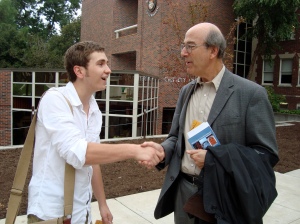 Can we really blame college educated 20 somethings for not finding work? The movie, “Post Grad,” is an all too familiar scenario many college graduates are facing.
Can we really blame college educated 20 somethings for not finding work? The movie, “Post Grad,” is an all too familiar scenario many college graduates are facing.
The 2009 movie stars Alexis Bledel, who plays a recent college graduate who seems to have done everything to land her dream job at Happerman and Brown Publishing. She’s earned a good GPA and she’s done three internships at top publishing firms, yet she still can’t land a single job with her degree and is forced to move back in with her family.
If young people today did all the cookie cutter tasks that set them to get good jobs, why hasn’t it happened for so many college graduates?
“It’s the hardest thing in the world to write another cover letter about your great accomplishments if you question every day the greatness of your accomplishments,” says Luke Stacks, who was on his way to finishing his doctorate program in American Studies, when he moved back home with his mom and decided to change careers.
Stacks’s story, which appeared in Good‘s quarterly news magazine, is similar to the 2 million young adults who have a bachelor’s and are without work.
Back in 2006, an article by Reuters reported that, “one study found 80 percent of students on the eve of graduation did not have jobs lined up and 67 percent were not confident in their chosen career path.”
Four years later in 2010, CNN Money reported that nearly 15% of young adults ages 20-24 [found] themselves unemployed and moving back in with their parents.
CNN also reported the findings of a poll by Twentysomething Inc., which discovered that 85% of college seniors decided to move back home with their parents after graduating in May 2010.
The founder of Twentysomething Inc, David Morrison said, “There’s almost an expectation that kids will move back home, there is no stigma attached. The thought now is to move home for 6-12 months but in reality those young adults will be home for a year and a half or longer. Even if they have jobs, they are living at home.”
Young graduates don’t expect their first job to be their ideal job, but studies by Northeastern University economics professor Andrew Sum, indicate that working at a job that does not require a college degree, will lead to earnings that are less than 40 percent than the earnings of college students whose jobs require a degree, and that the longer one stays at a non-degree job, the less likely he or she will return to the college-educated workforce.
 “Young college graduates are vastly underutilized. They go ahead and complete school and we don’t have anything to offer them once they’re out,” said Sum.
“Young college graduates are vastly underutilized. They go ahead and complete school and we don’t have anything to offer them once they’re out,” said Sum.
There’s also the issue of being overqualified, underqualified, and just not being the right amount of qualified. Kristen Vockel moved back home after she graduated with $30,000 in student loans, but like so many college graduates, she still doesn’t want to take the type of jobs she could have done without a college degree. “Why did I bother taking all of those tests and writing all of those papers and working so hard all of those years if I just have to go back to working the same jobs I worked before?” she says.
In some ways, Thomas H. Benton also felt he deserved to have a good job when he graduated back in 1990 with a bachelor’s degree in English. During his undergraduate years, Benton was in the school’s honors program, received good grades, and had good recommendations. He graduated without much work experience, but his internships and jobs lead him into many sales positions.
“Knowing what I know now, that scenario doesn’t seem all that bad, even though at the time, I regarded it as beneath me because none of my co-workers had read Moby-Dick or Ulysses,” wrote Benton in the advice column of The Chronicle of Higher Education. “In the end, it was that arrogance —and the promise of extraordinary job opportunities for college professors (announced everywhere in the early 90s) —that lured me back to graduate school.”
Benton received his bachelors during a recession, and like many post graduates, decided to wait out the current recession by enrolling in graduate school. Graduate school may help some people increase their potential earnings, but without adequate work experience and running the risk of going further into debt, it might be better to work for at least a year or so and then attend graduate school.
Looking for a job isn’t fun. The competition in the job market is tougher than ever before for the limited amount of positions open for college graduates who lack the working experience and bargaining power of more older and experienced workers.
There’s also the outsourcing of jobs to people outside of the United States who would work at cheaper wages and in poorer conditions.
Some people argue that parents are partly at fault by allowing their children to move back home, whereas others say graduates need to put aside their sloth behavior and get a job -any job.
However, some studies showed that some young adults weren’t just sitting around and doing nothing. They were volunteering and were taking their time to find a career in which they’ll enjoy so that unlike the working adults around them, they would try to get things right the first time around.
 The good news for the graduating class of 2011 is that job prospects are expected to be better for 2011 graduates than for 2010 graduates.
The good news for the graduating class of 2011 is that job prospects are expected to be better for 2011 graduates than for 2010 graduates.
Based on a study by the National Association of Colleges and Employers (NACE) 24 percent of 2010 college graduates had jobs awaiting after graduation, which was higher than the 20 percent found in 2009.
In the same study, employers said that they expected to hire 13.5 percent more graduates in 2011 than they hired in 2010.
It might not be easy to find the perfect job, the ideal job, or even a decent job, but if students in the past were able to overcome challenging prospects upon graduation, then there just might be hope for future graduates.
var _gaq = _gaq || [];
_gaq.push([‘_setAccount’, ‘UA-25496664-1’]);
_gaq.push([‘_trackPageview’]);
(function() {
var ga = document.createElement(‘script’); ga.type = ‘text/javascript’; ga.async = true;
ga.src = (‘https:’ == document.location.protocol ? ‘https://ssl’ : ‘http://www’) + ‘.google-analytics.com/ga.js’;
var s = document.getElementsByTagName(‘script’)[0]; s.parentNode.insertBefore(ga, s);
})();


















